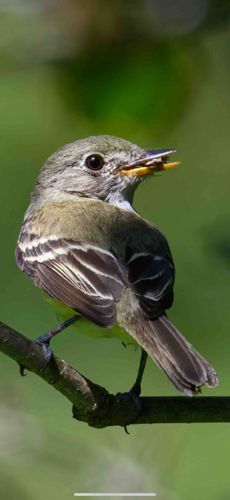Acadian Flycatcher
Classification: Empidonax virescens (Family: Tyrannidae)

Brief Description
A small, olive-green flycatcher with a relatively large head, distinctive eye-ring, and a pale chest.
Additional Information
- Region of Origin: Eastern North America, primarily the eastern United States and parts of southeastern Canada.
- Typical Sighting Period: Breeding season in temperate North America (late spring to late summer); winters in Central and northern South America.
- Plumage Details: Adults have olive-green upperparts, a distinct whitish eye-ring, pale whitish underparts with a yellowish wash on the flanks and belly, and two whitish wing bars. The bill is dark above and yellowish below.
- Ecological Significance: As an insectivore, it plays a role in controlling insect populations. It is also an indicator species for healthy deciduous and mixed forests.
- Conservation Status: Least Concern (though populations may be declining in some areas due to habitat loss)
- Observation Tips: Listen for its characteristic 'pitts-sa' call. Look for it in the mid-story of mature deciduous or mixed forests, often near water, where it perches and sallies out to catch insects.